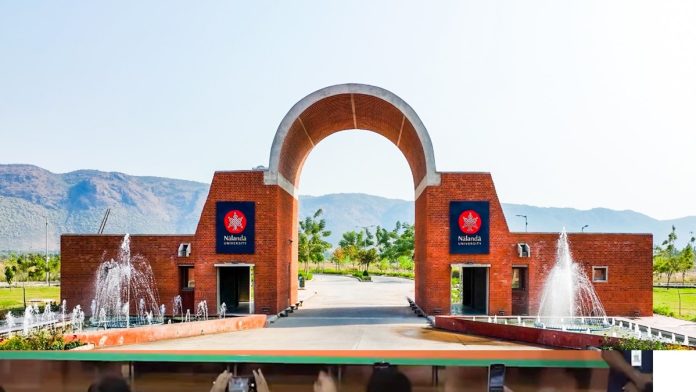A historic day for education is marked with the inauguration of Nalanda University’s new campus in Rajgir, Bihar by India’s PM Narendra Modi. The university, known globally for its academic heritage, reopens with a focus on excellence and sustainability and the inauguration ceremony was attended by several respected people, including the Head of Missions of 17 Countries and Chief Minister Nitish Kumar. The new campus of Nalanda University was also conceived as a collaboration between India and East Asia Summit (EAS) countries. It is a ‘Net Zero’ Green Campus focusing on environmental conservation, campus has two academic blocks with 40 classrooms where around 1900 students can study and two auditoriums each with a seating capacity of 300 students.
Nalanda University: Old Campus
- Nalanda University was built in the 5th century CE and attracted scholars by its excellence in various disciplines.
- The library of Nalanda University, “Dharma Gunj” or “Mountain of Truth,” had nine million books and some of the most sacred manuscripts.
- It was the world’s first residential university accommodating over 10,000 students and over 2000 teachers and had a major centre for Buddhist studies covering subjects like astronomy, medicine, logic, and mathematics.
- Located in the Nalanda ruins, it was declared a Unesco World Heritage Site in 2016 emphasising the site’s immense cultural and historical importance and the idea to revive Nalanda University was proposed by former president APJ Abdul Kalam in 2006.
- Nalanda University reopened in 2014, after nearly 800 years, marking a significant milestone in the history of the world’s oldest centres of learning.
Nalanda University: New Campus
- A student hostel accommodating 550 students, an international centre, an amphitheatre for up to 2,000 students, a faculty club, a sports complex, and several other amenities.
- The new campus defines the revival of the ancient university, combining ancient wisdom with modern knowledge.
- Mathematician Aryabhatt is also believed to have studied and taught in Nalanda.
- It attracted students from Korea, Japan, China, Mongolia, Sri Lanka, Tibet and Southeast Asia.
- It is self-sustainable with solar plants, domestic and drinking water treatment plants, water recycling plants for reusing wastewater, 100 acres of water bodies, and many other environment-friendly facilities.
- The university offers 137 scholarships to international students.
- The international students enrolled in the Post Graduate programmes for the academic years 2023-25 and PhD programme in 2023-27 include students from Argentina, Bangladesh, Bhutan, Cambodia, Ghana, Indonesia, Kenya, Laos, Liberia, Myanmar, Mozambique, Nepal, Nigeria, Republic of Congo, South Sudan, Sri Lanka, Serbia, Sierra Leone, Thailand, Turkiye, Uganda, USA, Vietnam and Zimbabwe.
- The university has six schools including the School of Buddhist Studies, Philosophy & Comparative Religions; the School of Historical Studies; the School of Ecology and Environmental Studies; and the School of Sustainable Development and Management.
Key Points
Nalanda University currently operates seven schools:
➤ School of Ecology and Environment Studies
➤ School of Historical Studies
➤School of Buddhist Studies, Philosophy and Comparative Religions
➤School of Languages & Literature/ Humanities
➤School of International Relations and Peace Studies
➤Business Management about Public Policy and Development Studies
Nalanda University provides multiple programs including postgraduate, doctoral, diploma, and certificate courses across various disciplines:
Nalanda University Admissions: Master’s Programs
MA in Buddhist Studies, Philosophy & Comparative Religions
MA in Hindu Studies (Sanatana)
MA in Historical Studies
MA in World Literature
MSc in Ecology and Environment Studies
MBA in Sustainable Development & Management
Nalanda University Admissions: PhD Programs
PhD in Buddhist Studies, Philosophy and Comparative Religions
PhD in Ecology and Environment Studies
PhD in Historical Studies
Diploma and Certificate Courses:
Courses available in Sanskrit, English, Korean, Yoga, Pali, and Tibetan
Nalanda University Admissions: Eligibility Criteria
For Master’s Programs, candidates must have three years of Bachelor’s degree (10+2+3) in the relevant language or any subject. Class 12 with at least 55% aggregate
For PhD Programs, candidates must:
Secure at least 65% aggregate in a relevant stream
Post Graduate Diploma programs require: A minimum three-year Bachelor’s degree in the relevant subject
Nalanda University Act
On 28 March 2006, former President of India APJ Abdul Kalam proposed the revival of Nalanda University during his address to the Joint Session of the Bihar Vidhan Mandal. In 2007, the Bihar Legislative Assembly passed a bill for this new university.
The Nalanda University Bill, 2010 was subsequently approved by the Rajya Sabha on August 21, 2010, and by the Lok Sabha on August 26, 2010. The bill received Presidential assent on September 21, 2010, officially becoming an Act. The university was inaugurated on November 25, 2010, marking the commencement of its operations.
This modern campus, designed to reflect the historic legacy of Nalanda University, symbolizes a blend of contemporary academic excellence and traditional heritage and it became a hub for global learning by encouraging international collaboration and innovation. This development revitalizes an ancient seat of learning. India’s commitment to education and research, making the way for future generations to engage in scholarly pursuits on a global stage.






























